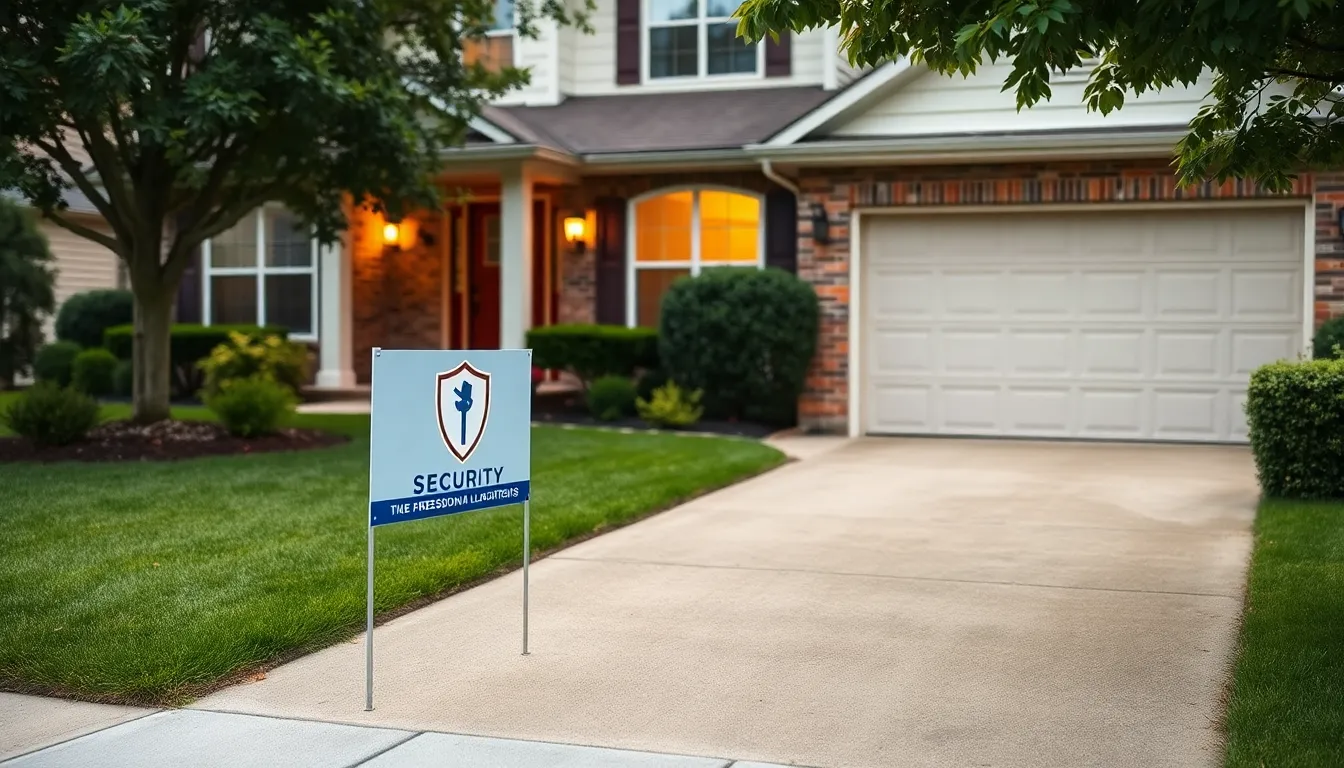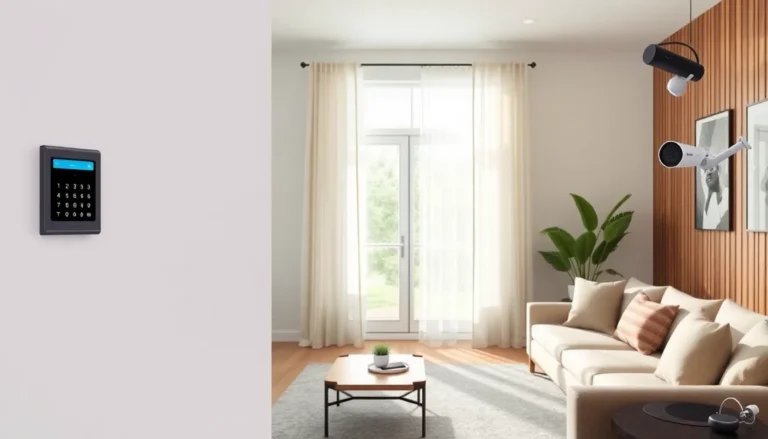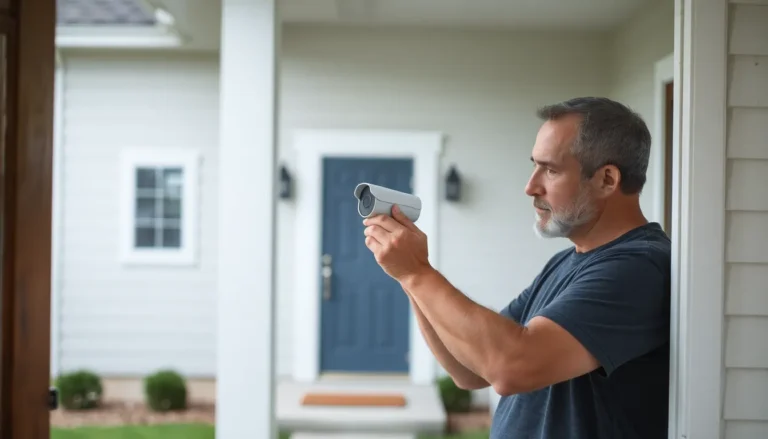Home security signs might just be the unsung heroes of neighborhood safety. They stand guard at the edge of lawns, silently proclaiming “not today, intruders!” While they may not have capes, their presence can deter even the most daring burglars. After all, who wants to mess with a house that’s clearly armed with an invisible fortress?
These signs do more than just look tough; they send a clear message that your home is protected. Whether it’s a flashy alarm system or a simple “Beware of Dog” sign (even if Fido’s more of a couch potato), these markers play a crucial role in keeping homes safe. So, let’s dive into the world of home security signs and discover how they can transform your property into a fortress that even the sneakiest of thieves wouldn’t dare approach.
Table of Contents
ToggleImportance of Home Security Signs
Home security signs play a critical role in deterring crime. Their presence signals that a property is protected, making it less attractive to burglars. Professionals agree that homes displaying security signs are targets less frequently than those without them. Statistics indicate that many intruders avoid houses marked with signs or security systems.
A combination of clear warnings and visual deterrents reinforces safety. Common signs, such as “Beware of Dog” or “Protected by [Security Company],” effectively communicate the risks of attempting burglary. When neighbors see these signs, they gain confidence in the overall security of their community.
Additionally, signs can create a perception of vigilance among homeowners, further reducing the likelihood of crime. Some studies suggest that neighborhoods with visible security measures experience a drop in crime rates compared to those without.
Using professional-grade signage enhances credibility. Properly branded signs convey that a homeowner invests in security, which can discourage criminal activity. They also foster a sense of community safety by encouraging residents to be aware of their surroundings.
Integrating these signs with home security systems maximizes protective benefits. An alarm system’s physical indicators, like yard signs and window stickers, communicate that a monitored environment exists. Homeowners engaging in this practice not only protect their property but also contribute to a safer neighborhood.
Types of Home Security Signs

Home security signs come in various forms, each serving a specific purpose in deterring potential intruders. Understanding these types can enhance overall security measures.
Yard Signs
Yard signs act as a prominent visual deterrent. Displaying a security company’s logo signals that the property is protected. Research shows homes marked with yard signs are less likely to be targeted by burglars. Many professionals recommend placing these signs in visible areas, such as near the driveway or front porch. Signs indicating alarm systems significantly enhance the perception of security among neighbors. Bold graphics and clear wording make these signs easy to notice, reinforcing the homeowner’s commitment to safety.
Window Decals
Window decals provide an additional layer of security visibility. Placing them on front-facing windows alerts passersby that the home has security measures in place. Decals often include messages like “Protected by [Security Company]” or “24-Hour Surveillance.” Their visibility from the street increases the likelihood that potential intruders will reconsider their approach. These decals, which are easy to apply and remove, can also change location or design without any hassle. Selecting high-quality materials ensures durability and clarity, contributing to long-lasting crime deterrence.
Effectiveness of Home Security Signs
Home security signs play a crucial role in enhancing property safety and deterring crime. They clearly signal protection, making homes less appealing to potential burglars.
Deterrence of Criminal Activity
Research shows that homes with security signs face lower rates of break-ins. Many criminals avoid properties marked by signs, perceiving them as riskier targets. In fact, studies indicate that nearly 60% of convicted burglars stated they would steer clear of homes with visible security measures. Signs alert intruders to the possibility of alarm systems or video surveillance. Increased deterrence comes not just from the signs themselves but also from the perception they create within the community. Displaying these signs makes it clear that vigilance exists, thereby reducing crime rates in neighborhoods.
Psychological Impact on Homeowners
The presence of security signs boosts homeowners’ confidence in their safety. Many individuals feel a stronger sense of security when they see these indicators around their homes. Knowing that they’ve taken proactive measures reinforces their peace of mind. Families often report feeling more at ease, which contributes to a greater quality of life. Homeowners benefit from a shared sense of safety that these signs foster within the community. Additionally, confident residents are more likely to engage with their neighbors in maintaining a safe environment.
Designing Your Home Security Signs
Designing effective home security signs involves careful consideration of messaging and materials. Clear and direct messages capture attention and convey important security information.
Choosing the Right Messaging
Simple messaging works best for security signs. Warnings such as “Protected by Alarm” or “Beware of Dog” effectively communicate safety measures. Intruders often avoid properties with strong messages, as nearly 60% of burglars would bypass homes displaying security signs. Attention-grabbing language reinforces the perception that the home is actively protected. Incorporating action words like “Alert” or phrases emphasizing immediate danger can enhance deterrence. Ensure that the language remains concise while still providing sufficient information about the security features in place.
Selecting Materials and Sizes
Material choice significantly impacts the effectiveness of security signs. Durable materials like weather-resistant plastic or aluminum withstand outdoor conditions. Quality signage remains visible, regardless of environmental factors, leading to increased deterrence. Sizes should balance visibility and aesthetics; larger signs attract attention without overwhelming the property. For yard signs, dimensions around 18×24 inches capture attention from a distance. Window decals should maintain clarity and legibility, so options measuring 4×6 inches often work well. Prioritizing high-quality signs strengthens credibility, communicating a serious commitment to security to potential intruders and neighbors alike.
Legal Considerations
Homeowners must navigate various legal issues when displaying security signs. Local regulations may dictate the size, placement, and type of signage permitted. Familiarity with these rules ensures compliance and avoids potential fines.
Displaying false or misleading information on security signs poses legal risks. Accuracy in claims, such as stating the presence of an alarm system, is crucial. Misleading signals can lead to liability if an incident occurs, as homeowners may face legal repercussions.
Homeowners association (HOA) guidelines can also affect signage choices. Certain communities impose restrictions on sign visibility or content. Checking HOA rules prevents conflicts and maintains community standards.
Additionally, privacy laws apply when using security cameras. Signs indicating surveillance are necessary to inform visitors about monitoring. Compliance with privacy regulations ensures that footage isn’t misused while protecting homeowner rights.
Property boundaries affect sign placement as well. Adhering to property lines avoids disputes with neighbors. Proper positioning demonstrates respect for both individual property rights and community aesthetics.
Insurance policies often require specific signage for coverage eligibility. Insurers may stipulate that signals indicating security systems must be visible to qualify for discounts. Confirming with an insurance agent guarantees that homeowners meet necessary conditions.
Awareness of local crime trends can influence signage strategy. Neighborhood watch programs might advocate for certain types of signs to enhance safety. Engaging with local law enforcement can provide valuable insights while fostering community ties.
Overall, understanding legal considerations strengthens the effectiveness of home security signs and cultivates a safer neighborhood.
Home security signs play a vital role in creating safer neighborhoods. They act as a strong deterrent against crime while fostering a sense of community vigilance. By choosing high-quality signage and ensuring proper placement, homeowners can effectively communicate their commitment to security. This not only protects their property but also encourages neighbors to take proactive steps in safeguarding their own homes.
Understanding local regulations and legal considerations is essential for maximizing the benefits of these signs. Ultimately, the strategic use of home security signs enhances personal safety and contributes to a collective effort in reducing crime rates, making communities more secure for everyone.



